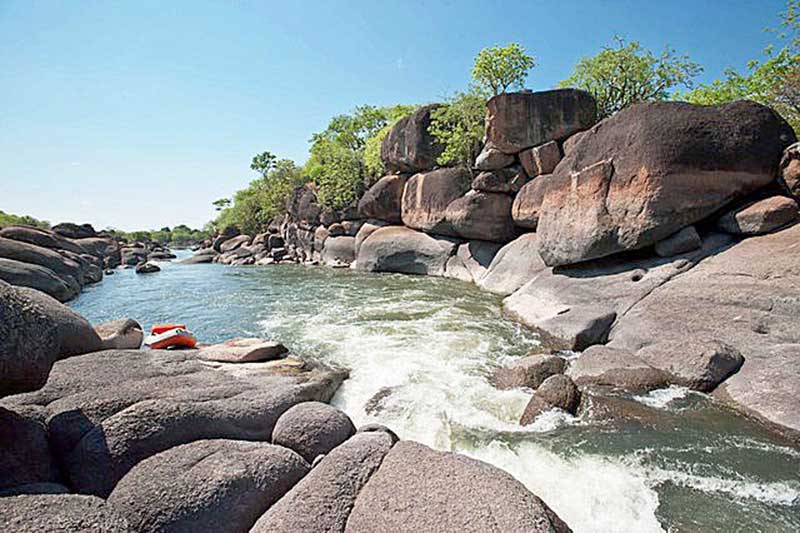Zambia Travel Guide Index
Zambia Travel Guide Index you to discover the best places to visit and experience Zambia’s three great rivers. These are the Zambezi, the Kafue and Luangwa.
Home of the legendary walking safari, Zambia has much to offer the visitor. Remote regions beckon with an abundance and diversity of wildlife and a wealth of birdlife.
Raft the rapids at Victoria Falls or canoe the wide Zambezi river. South Luangwa awaits with its incredible leopard sightings.

The small town of Livingstone used to be Zambia’s capital but later moved to Lusaka (too many mosquitos).
Also known as Maramba and named after David Livingstone, the town offers a myriad of activities.
At the Livingstone Museum you will get an insight into the cultural development of the country.
There is also the Ethnography and Art Gallery, a natural history section.
For lovers of the steam engine visit the Railway Museum on Chishimba Falls road.
At Gwembe see a large collection of crocs and snakes.


This national parks lies opposite Mana Pools. The landscape is awesome; the backdrop is the Zambezi escarpment which forms a barrier to the Park’s wildlife and the Zambezi river runs through the park.
Still very much a wilderness area, canoe safaris are very popular and offer guests the chance to get really close to the wildlife without spooking them.
Wildlife you can expect to see includes elephant, buffalo, hippo, crocs, waterbuck, kudu, zebra, eland, samango monkey, hyena, civet, honey badger, genet, civet, lion, leopard.
On the Birdlife menu look for fish eagle, white-fronted and carmine bee eaters, red-winged pratincole, crested guinea fowl, black eagle, quelea, narina trogon, trumpeter hornbill, Meyers parrot and Lilian’s lovebird.
Seasons
From April to May, the main wet season has gone, the grass is high and the migrant birds begin to leave. At the end of May our most remote safari camps re-open.
Winter time comes in June and July, which is also our dry season, and although it’s warm by day, you’ll need a jacket at night as it gets chilly.
September brings hot, hazy weather and a riot of flowers on the trees. It’s an excellent time to see game, and if you’re a birder then you’ll see the Carmine bee eaters nesting from now until November.
In October it gets very hot, up to 40 degrees in the shade. This is the end of our dry season when our camps that are located far in the bush, close.
With November and December comes the onset of the rains, the migrant birds return, the bush sprouts new life and begins to bursts into vivid green, heralding the start of another Emerald Season.
The beginning of the rains can also bring a deluge of flying ants and other insects (sometimes in pretty big proportions, but normally lasting a few hours). With the insects come the cooler temperatures but also the humidity.

Kafue
is one of Africa’s largest parks with access from Livingstone or Lusaka and still remains unexplored.
Here you will find Sitatunga, lechwe, roan, sable, hartebeest, cheetah, wild dog, hippos, crocs, puku, impala, pangolin, civet, several, bush baby, honey badger and the list goes on.
Rare species include blue and yellow backed duiker.
Birding is out of this world with over 500 recorded species : Pel’s Fishing Owl, Black-cheeked Lovebird, Chaplin’s Barbet (Zambia’s only endemic bird)
This national park is often regarded as one of the great parks in the world and it’s easy to see why.
For the birder and wildlife enthusiast there is a lot on offer.In this region there are approx. 400 species of birds of which 39 are birds of prey and 47 migrants.
Wildlife sightings include kudu, zebra, hippo, crocs, impala, eland, bushbuck and 14 other antelope species.
Leopard, elephant, lion, buffalo, Thornicroft’s giraffe, and more.
Insurance & Medical
Make sure that you have comprehensive medical and travel insurance before you arrive.
You must have malaria protection and we recommend tetanus and the hepatitis vaccinations. It is advisable to know your blood group type in case of emergency.
Photography
Please be sensitive when photographing local people and their villages. Ask the guide or the villagers first. Be careful when photographing public buildings and persons in uniform – just ask first.
What to Bring
A hat, high-strength sun screen, strong insect repellent, anti-histamine cream and tablets are essentials.
Pack soft bags, not hard cases. Torch – binoculars – 3 sets of bush-coloured safari outfits, two sets of casual evening clothes and a medium-weight sweater plus a warm jacket if you come in Winter (June – early August).
Bring a good pair of walking shoes – thick-soled trainers are fine for camp walks but bring light boots for the walking safaris.
If you wear lenses, the dust may be a challenge, so pack glasses (possibly plus an extra pair)
